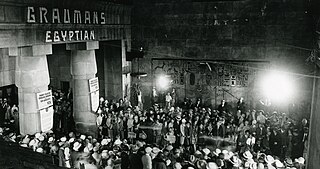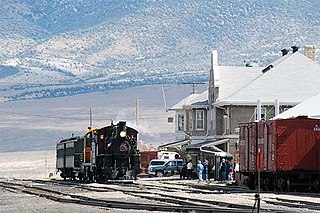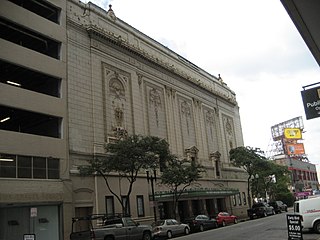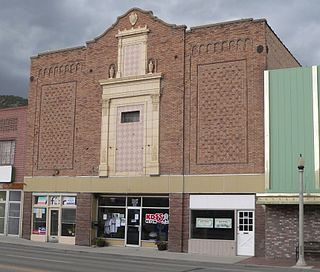
Grauman's Egyptian Theatre, also known as Egyptian Hollywood and the Egyptian, is a historic movie theater located on Hollywood Boulevard in Hollywood, Los Angeles, California. Opened in 1922, it is an early example of a lavish movie palace and is noted as having been the site of the world's first film premiere.

The Alabama Theatre is a movie palace in Birmingham, Alabama. It was built in 1927 by Paramount's Publix Theatres chain as its flagship theater for the southeastern region of the United States. Seating 2,500 people at the time, it was the largest in the Birmingham theater district. The district was once home to many large theaters and movie palaces that featured vaudeville, performing arts, nickelodeons and Hollywood films. Built to show silent films, the Alabama still features its original Wurlitzer theater organ. The Alabama Theatre and Lyric Theatre are the district's only remaining theaters, and as of 2024, both are in operation.

Playhouse Square is a theater district in downtown Cleveland, Ohio, United States. It is the largest performing arts center in the US outside of New York City. Constructed in a span of 19 months in the early 1920s, the theaters became a major entertainment hub for the city for much of the 20th century. However, by the late 1960s, the district had fallen into decline and its theaters had closed down. In the 1970s, the district was revived through a grassroots effort that helped usher in a new era of downtown revitalization. For this reason, the revival of Playhouse Square is often locally referred to as being "one of the top ten successes in Cleveland history."

The Nevada Northern Railway Museum is a railroad museum and heritage railroad located in Ely, Nevada, owned by the State of Nevada and operated by a historic foundation dedicated to the preservation of the Nevada Northern Railway.

The Kings Theatre is a theater and live performance venue at 1027 Flatbush Avenue in the Flatbush neighborhood of Brooklyn in New York City, United States. Designed by Rapp and Rapp as a movie palace, it opened on September 7, 1929, as one of five Loew's Wonder Theatres in the New York City area. The theater's interior decor was supervised by Rapp and Rapp along with Harold Rambusch. Owned by the New York City Economic Development Corporation, the Kings Theatre has been operated by the Ambassador Theatre Group since 2015. It is listed on the National Register of Historic Places.

The Midland Theatre is a 3,000-seat theater located in the Power & Light District of Kansas City, Missouri, United States. The National Collegiate Athletic Association under Walter Byers had its headquarters in the building from the 1950s until it moved to 6299 Nall Avenue at Shawnee Mission Parkway in Mission, Kansas in 1971. The theatre was originally known as the Loew's Midland Theatre until 1961. Over the years, the theatre has been known by various names including: Saxon Theatre, Midland Stadium, Midland 1-2-3 Theatre, Midland Theatre and The Midland by AMC, and Arvest Bank Theatre at The Midland.

The Chicago Theatre, originally known as the Balaban and Katz Chicago Theatre, is a landmark theater located on North State Street in the Loop area of Chicago, Illinois. Built in 1921, the Chicago Theatre was the flagship for the Balaban and Katz (B&K) group of theaters run by A. J. Balaban, his brother Barney Balaban and partner Sam Katz. Along with the other B&K theaters, from 1925 to 1945 the Chicago Theatre was a dominant movie theater enterprise. Currently, Madison Square Garden, Inc. owns and operates the Chicago Theatre as a 3600 seat performing arts venue for stage plays, magic shows, comedy, speeches, sporting events and popular music concerts.

The Fox Oakland Theatre is a 2,800-seat concert hall, a former movie theater, located at 1807 Telegraph Avenue in Downtown Oakland. It originally opened in 1928, running films until 1970. Designed by Weeks and Day, the theatre is listed on the National Register of Historic Places. It was refurbished in the 2000s and reopened as a concert venue on February 5, 2009.

The James M. Nederlander Theatre is a theater located at 24 West Randolph Street in the Loop area of downtown Chicago, Illinois. Previously known as the Oriental Theatre, it opened in 1926 as a deluxe movie palace and vaudeville venue. Today the Nederlander presents live Broadway theater and is operated by Broadway In Chicago, currently seating 2,253.

Huntridge Theater, sometimes known as the Huntridge Performing Arts Theater, is a Streamline Moderne building located in Las Vegas, Nevada, that is listed on the United States National Register of Historic Places. The building was designed by S. Charles Lee.

Saenger Theatre is an atmospheric theatre in downtown New Orleans, Louisiana, which is on the National Register of Historic Places. Once the flagship of Julian and Abe Saenger's theatre empire, today it is one of only a handful of Saenger movie palaces that remain.

The Senator Theatre is a historic Art Deco movie theater on York Road in the Govans section of Baltimore, Maryland. It is the oldest operating movie theater in central Maryland and is listed on the National Register of Historic Places and is a designated Baltimore City Landmark.

The Uptown Theater, known as The Uptown, was a single-screen movie theater in the Cleveland Park neighborhood of Washington, D.C. Opened in 1936, it hosted the world premieres of such movies as 2001: A Space Odyssey and Jurassic Park. It closed in March 2020.

The Orpheum Theater is a theater in the Central Business District of New Orleans, Louisiana.

Venetian Hillsboro, last known as the Venetian Theatre & Bistro, is a former movie theater and performing arts venue in downtown Hillsboro, Oregon, United States, which since 2022 has been in use by a venue named Venetian Hillsboro. Formerly the Town Theater, the building re-opened in 2008 after more than a decade of inactivity and revitalization plans. Built in 1888 as a bank, later mayor Orange Phelps converted the property into a theater in 1911 and in 1925 converted it into a two-story Italianate building with a larger auditorium. Prior to renovation the theater was owned by the city of Hillsboro who purchased it from Act III Theatres.

The Professional Building in Phoenix, Arizona is an Art Deco skyscraper. Built in 1932, it is 171 feet (52 m) tall. Angles and setbacks are played up in this streamlined Art Deco design. A central tower rises from the two-story base with a wing on the western side of the building. The entrances on Central Avenue and Monroe Street feature decorative grills above the doors.

The Capital Theater in Ely, Nevada was built in 1916 by C.O. Fleming and W.P. Hull. The building began as a vaudeville hall that hosted a diverse range of live entertainment, including acrobats, comedians, lecturers, and magicians. The building reopened as a cinema in 1923, at a time when films were becoming popular. The theater closed in 1963. The building's style represents a possible reconstruction after a 1929 fire, and might best be described as Spanish Colonial Revival. The theater's design was carried out by the owners.

The U.S. Post Office in Ely, Nevada was built to a standardized plan developed by the Office of the Supervising Architect, led by Louis A. Simon. The building uses an attenuated Classical style that was popular with Federal buildings in the 1930s. The post office opened on January 29, 1938, following delays in the start of construction. It closed in 2002, and was reopened in 2005 as a convention center for the nearby Hotel Nevada and Gambling Hall. That year, it was also listed on the National Register of Historic Places.

The Denis Theatre is a historic movie theater in Mt. Lebanon, Pennsylvania. It was built in 1938 by John P. Harris of the Harris Amusement Company, and was in business until 2008. It is currently seeking funding to be renovated and reopened in the near future.

Hotel Nevada and Gambling Hall, also known as the Historic Hotel Nevada and Gambling Hall, is a hotel and casino located at 501 Aultman Street in Ely, Nevada.






















